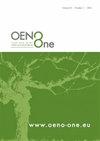柳杉上清液对葡萄酒中相关腐坏酵母的防治效果评价
IF 2.2
3区 农林科学
Q3 FOOD SCIENCE & TECHNOLOGY
引用次数: 0
摘要
SO2传统上用于限制或消除葡萄酒中腐败酵母的增殖,但由于其对人类健康的负面影响,其使用已引起争议。控制腐败酵母的另一种策略是使用生物控制酵母。异常Wickehamomyces anomalus是我们小组研究过的一种优秀的生物控制酵母,是一种很好的生物控制剂。应用微生物生物控制研究结果的挑战在于探索利用微生物生物控制活性的技术简单和经济的方法。外来微生物群的引入增加了发酵培养基的复杂性,并可能导致技术困难,并对混合培养的实施产生固有的酿酒学后果。因此,本研究的目的是对异头木浓缩培养上清液进行表征,并评价其在液体培养基中对两种主要葡萄酒腐败酵母的生物防治作用。异头W.anomalus BWa156上清液显示出抑制性杀伤蛋白特性。生物控制酵母产生的抑制性上清液与腐败酵母的存在或不存在无关。在有氧条件下,上清液的生产速度比传统发酵(即约24小时)更快,从而增加了其技术发展的潜力。用BWa156的上清液处理对两个腐败种群鲁氏酵母和布鲁克伦布列塔尼酵母是有效的,这两个种群被认为是葡萄酒工业的问题。生物控制酵母的上清液可以被认为是腐败种群的一个相关的额外应激因素,它与其他因素如乙醇、对营养物质、氧气和pH的竞争一起,有助于消除污染种群。这项技术将允许在未来进行简单的应用,通过在生物反应器中与发酵平行生产,并随后在必须/葡萄酒中接种。本文章由计算机程序翻译,如有差异,请以英文原文为准。
Evaluation of the application of Wickerhamomyces anomalus supernatant for the control of relevant spoilage yeasts in wines
SO2 is traditionally used to limit or nullify the proliferation of spoilage yeasts in must/wine, but its use has become controversial due to its negative effects on human health. An alternative strategy for the control of spoilage yeasts is the use of biocontrol yeasts. Wickerhamomyces anomalus is an outstanding biocontroller yeast that has been examined by our group and that is a good biocontrol agent against Brettanomyces bruxellensis and Zygosaccharomyces rouxii. The challenge regarding the application of the results of microbial biocontrol studies lies in exploring technologically simple and economical ways to make use of microbial biocontrol activity. The introduction of foreign microbiota adds complexity to the fermentation medium and can cause technological difficulties and have oenological consequences inherent to the implementation of mixed cultures. Therefore, the objective of this study was to characterise the concentrated culture supernatant of W. anomalus and evaluate its biocontrol action in liquid medium on two main wine spoilage yeasts. W. anomalus BWa156 supernatant demonstrated inhibitory killer protein characteristics. The production of the inhibitory supernatant by the biocontroller yeast was independent of the presence or absence of the spoilage yeast. Supernatant can be produced faster under aerobic conditions than in traditional fermentation (i.e., with around 24 h), thus increasing its potential for technological development. The treatment with the supernatant of BWa156 was effective against the two spoilage populations Zygosaccharomyces rouxii and Brettanomyces bruxellensis, which are considered problematic for the wine industry. The supernatant of the biocontrol yeast can be considered to be a relevant additional stress factor for the spoilage population, which together with other factors such as ethanol, competition for nutrients, oxygen and pH, contributes to the elimination of the polluting population. This technology would allow a simple future application, through its production in a bioreactor parallel to the fermentation and subsequent inoculation in the must/wine.
求助全文
通过发布文献求助,成功后即可免费获取论文全文。
去求助
来源期刊

OENO One
Agricultural and Biological Sciences-Food Science
CiteScore
4.40
自引率
13.80%
发文量
85
审稿时长
13 weeks
期刊介绍:
OENO One is a peer-reviewed journal that publishes original research, reviews, mini-reviews, short communications, perspectives and spotlights in the areas of viticulture, grapevine physiology, genomics and genetics, oenology, winemaking technology and processes, wine chemistry and quality, analytical chemistry, microbiology, sensory and consumer sciences, safety and health. OENO One belongs to the International Viticulture and Enology Society - IVES, an academic association dedicated to viticulture and enology.
 求助内容:
求助内容: 应助结果提醒方式:
应助结果提醒方式:


